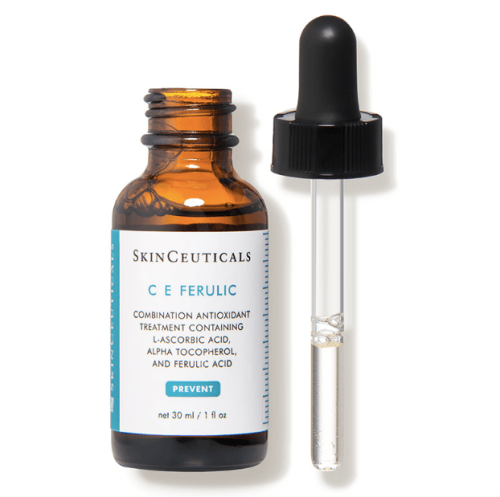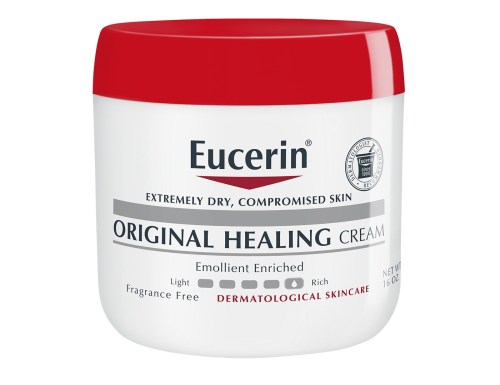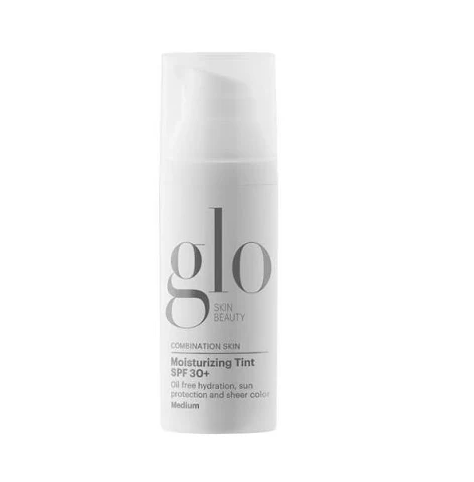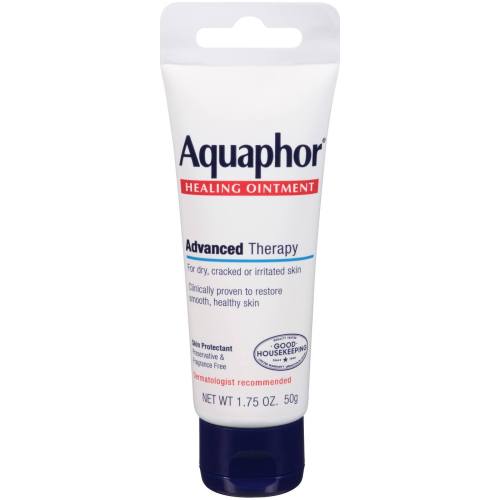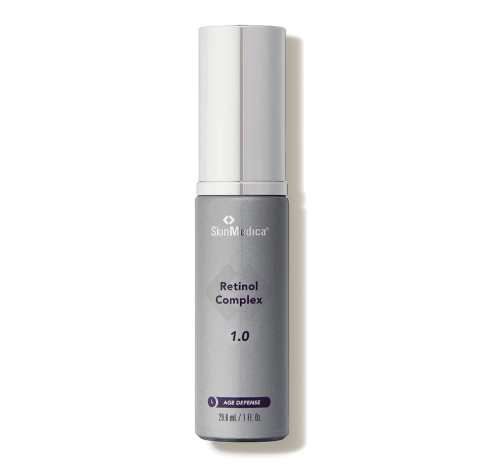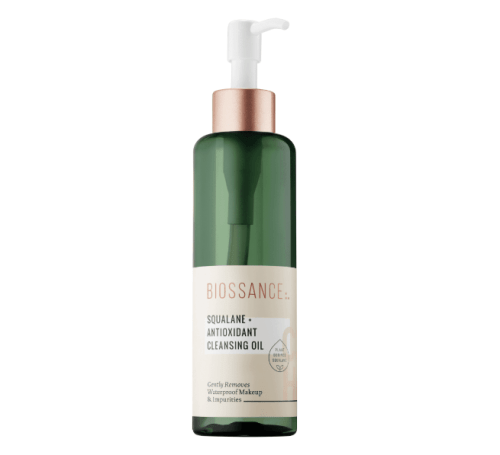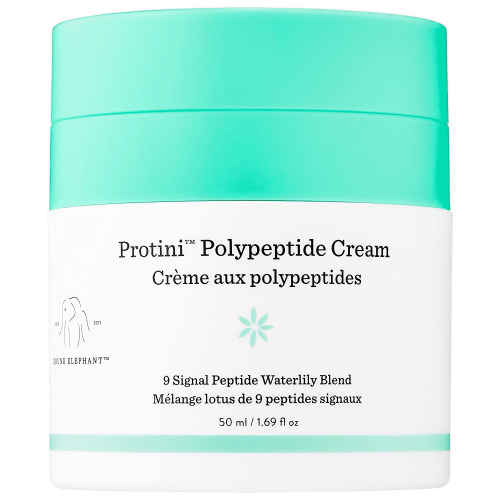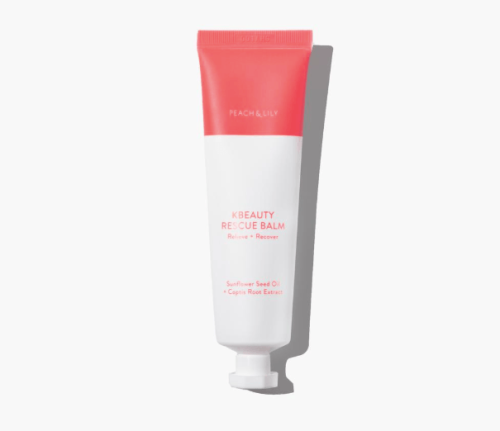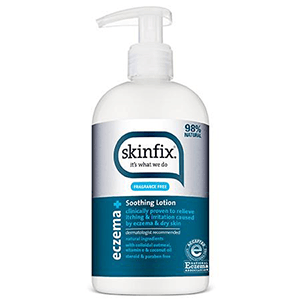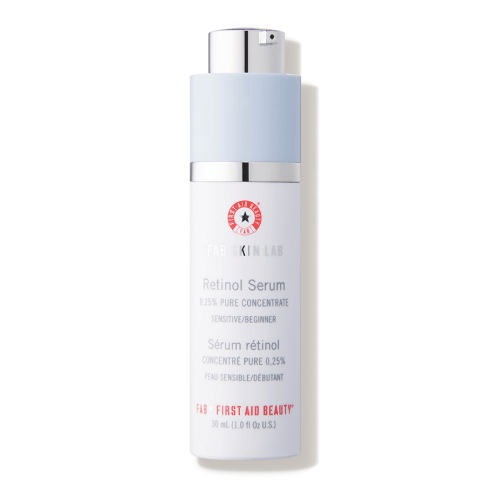A Dermatologist’s Road Map to Brighter, Happier Skin by February 1

Kim Nichols, MD, is a Greenwich, CT-based dermatologist our beauty editors have on speed dial. When she's not versing us in ingredients, she's schooling us on the right way to use them, which is why we called her to help us start the New Year off right. This four-week program is designed to reset, recharge, and revitalize your complexion, so that it's strong and ready to face whatever 2019 has in store.
Chances are, you've been adding and subtracting countless beauty products to (and from) your skin-care regimen all throughout the year—sometimes with success, sometimes...not so much. A skin-care journey is a lifelong pursuit, for sure; however, if you haven't yet built one that you're happy with, or if you're uncertain about whether or not your routine is working for you, January is a good time for a fresh start.
While there’s certainly nothing wrong with experimentation, I like to use the New Year as a time to reset and refresh my complexion. That means turning an eye to specific products that are really doing their job and those that aren’t. After all, your skin is your largest organ and the thing that shields you from everything coming at you in the world (from pollution to blue light to invisible little free radicals). Your beauty products and skin-care practices, then, should all be aimed at defending, nourishing, and hydrating so that your complexion can do the best job possible for you.

{{post.sponsorText}}
Over the course of the next 28 days, I want to help you take a look at what your skin really does need and how to address any problems or troubles you might be facing. And once we’re done, you’ll be on your way to your best skin ever in 2019.
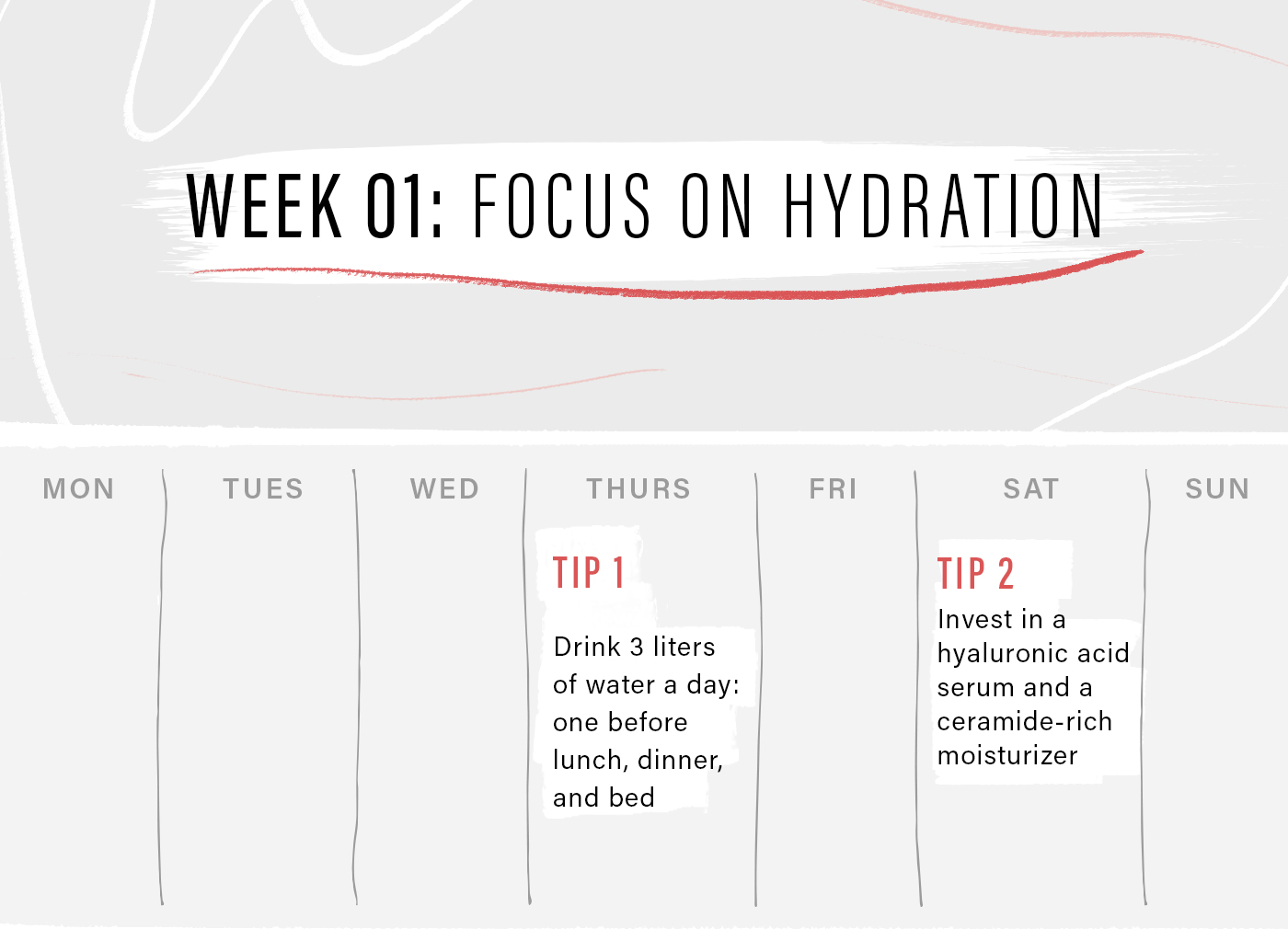
Week 1: Load up on hydration
Of course, drinking water helps your skin look healthy and stay young. If you’re not getting sufficient water, the lack of hydration will present itself by turning your skin dry, tight, and flaky. Dry skin has less resilience and isn’t as good at defending against external aggressors, leading to what we dermatologists call a “compromised skin barrier.” You can fix that with two easy behavior changes.
Tip 1: Drink 3 liters of water a day: one before lunch, dinner, and bed
It’s important to get your eight glasses a day. I say to fill up your water bottle, and make sure you’ve had a liter before lunch, a liter before dinner, and a liter before bed. Beyond that, carry your water bottle with you at all times so that you can always have some H2O on hand.
Tip 2: Invest in a hyaluronic acid serum and a ceramide-rich moisturizer
Once you have your internal hydration game locked down, focus on figuring out your external hydration game. Winter is the driest time of year, so it’s also important to hydrate your skin by slathering on hyaluronic acid serums (they’re moisture magnets and bind up to 100 times their weight in water within skin) as well as barrier-repairing creams with ceramides that provide an occlusive seal and prevent trans-epidermal water loss (AKA: water leaving your skin in favor of the dry, winter air).
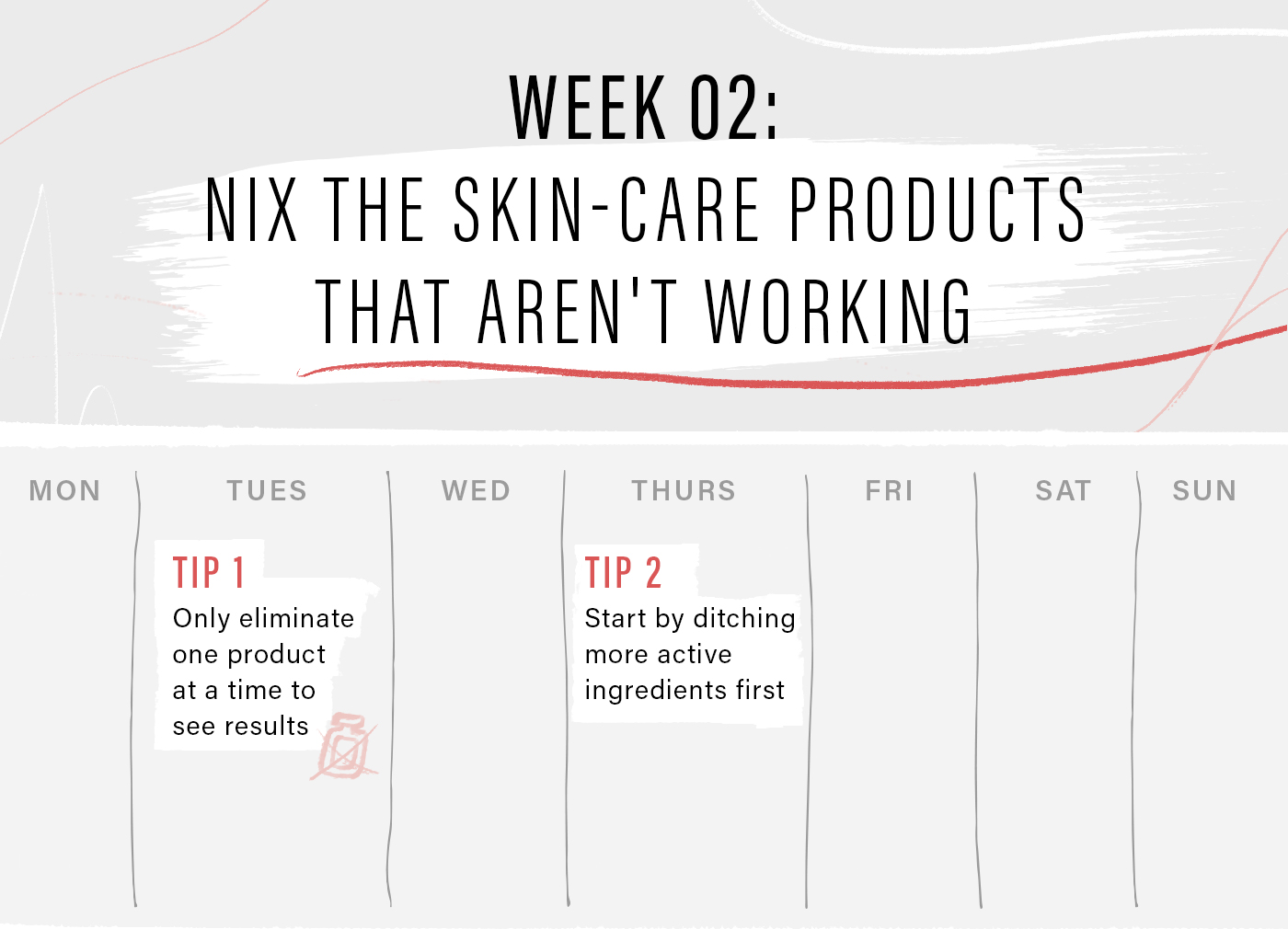
Week 2: Nix the skin-care products that aren't working
No skin type is exactly alike. Just because a product works for your best friend doesn't necessarily mean it'll work for you. To see which products in your regimen aren't working, look for signs of irritation: redness, dryness, itchiness, or lack of improvement in problem areas.
Tip 1: Only eliminate one product at a time to see results
It’s smart to think of your skin-care routine as you would an elimination diet, and stop using one product at a time to isolate what might be causing your skin to be upset and irritated. Once you’ve worked backward, if the irritation still persists, see a dermatologist to help decipher what’s what.
Tip 2: Start by ditching more active ingredients first
While “actives,” or key ingredients in skin-care products, are often to blame, any given formula could include something that you’re allergic to or are reacting oddly with. If your skin still isn’t playing nice with a retinol, try an alternative like bakuchiol. Skin is still parched despite moisturizing it? Perhaps your moisturizer isn’t the right one for you, and you may need a richer formula. If a spot treatment isn’t helping to shorten the lifespan of your breakout, choose a different active ingredient, like salicylic acid or benzoyl peroxide.
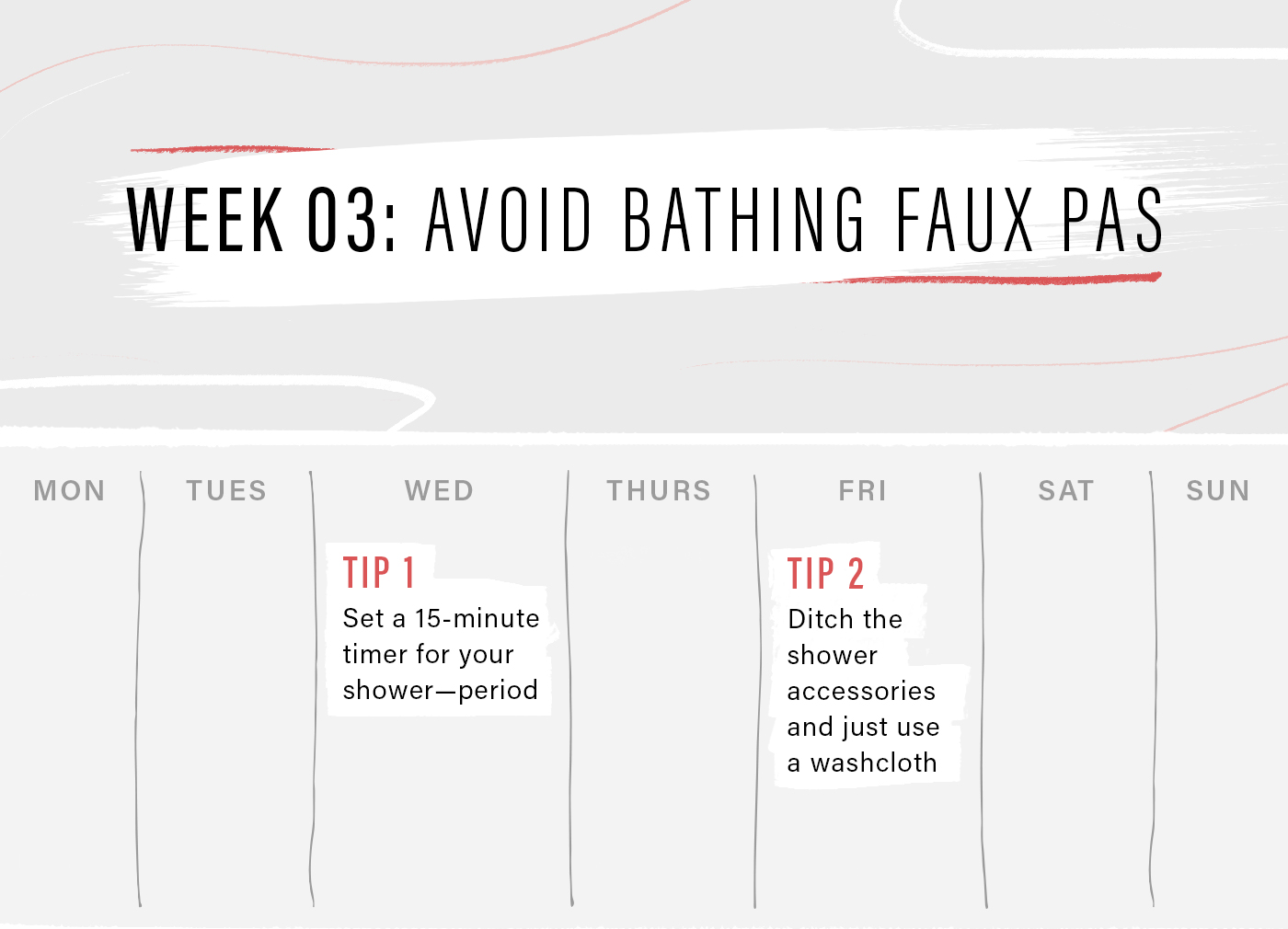
Week 3: Avoid bathing faux pas
Although you probably do it mindlessly at this point, the way that you're showering or bathing could potentially take a toll on your skin, causing irritation by drying it out or exfoliating it too deeply.
Tip 1: Set a 15-minute timer for your shower—period
Spend no more than 15 minutes in the hot water, because it can really dry out your skin. While you don’t technically have to shower every day, if you work out, you should wash off. Sweat that’s left behind on your skin proliferates bacteria, and this can lead to breakouts and other problems.
Tip 2: Ditch shower accessories and just use a washcloth
Even though you might love facial cleansing brushes and body exfoliating mitts, only tap them a few times a week rather than all the time. They’re very rough on skin and can be overdrying, which can inflame medical conditions such as psoriasis, rosacea, and eczema. They might feel soft, but over time, they can lead to damage. Similarly, don't dry off too roughly. The pulling and rubbing on your skin leads to loose elasticity, AKA sagging skin as a premature sign of aging. Be sure to lightly dab your skin after the shower for a gentler dry that keeps your skin healthy.
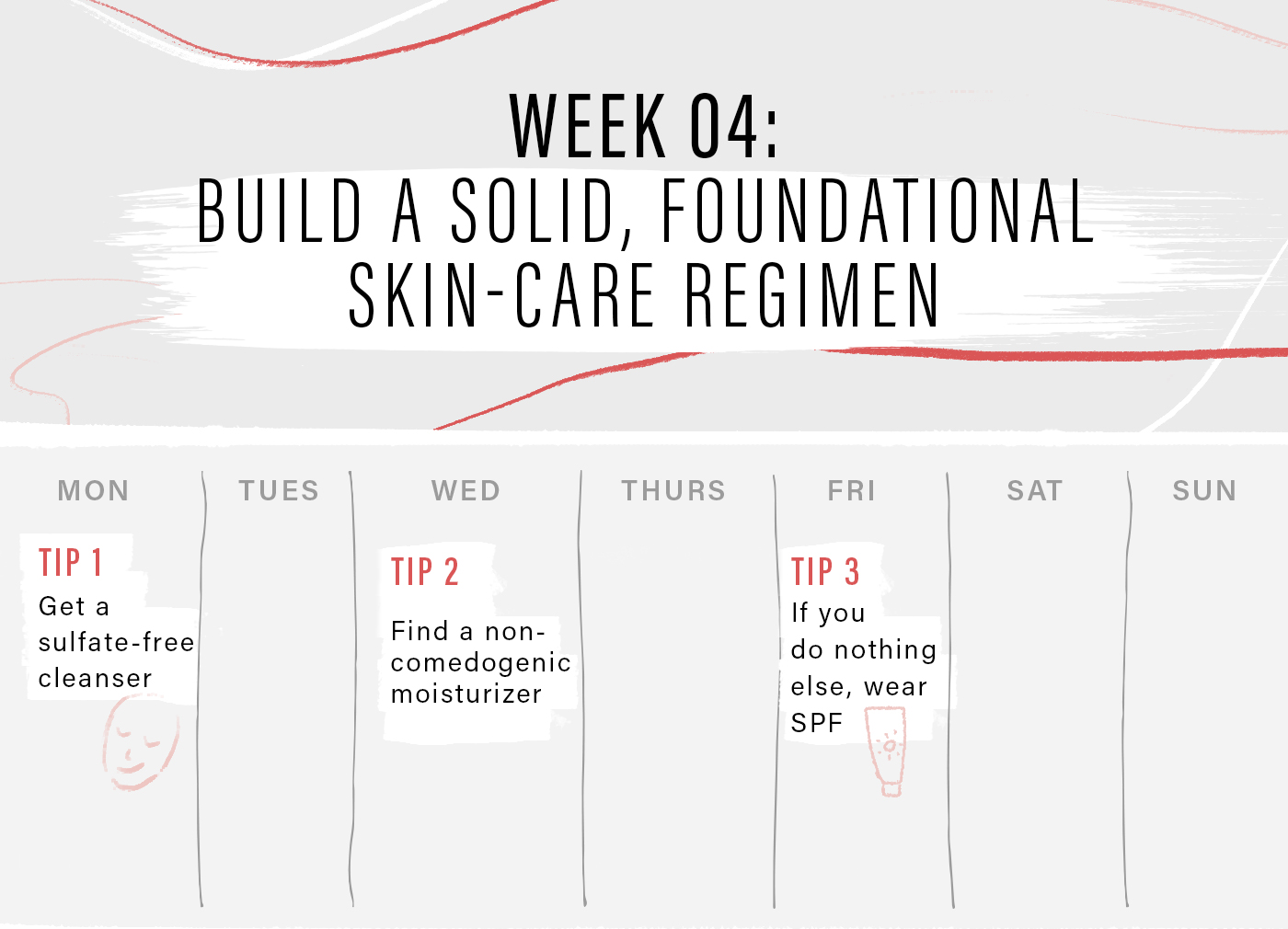
Week 4: Build a solid, foundational skin-care regimen
So, now it's time for the most important step of all: You need to build a regimen that works with your skin type. Consulting with a dermatologist is the best place to start here. They can help match you to the most scientifically backed skin-care products that'll produce real results. In my opinion, the key products to have in any solid skin-care routine are a gentle cleanser, moisturizer, sunscreen, an antioxidant serum, and a retinol.
Tip 1: Get a sulfate-free cleanser
Here's where to start in terms of cleansing: You need something that's gentle but efficient and good for your skin type. Avoid sulfates, which strip your skin of moisture and sacrifice its protective barrier. Instead, embrace those with aloe vera, coconut-based cleansing agents, and hydrating oils like jojoba.
Tip 2: Find a non-comedogenic moisturizer
For a moisturizer, make sure it's a non-comedogenic option. If you have oily skin, use an easy-to-absorb gel or something with jojoba oil, which mimics your skin's natural sebum and won't clog pores. If you're looking for something for those extra-dry patches of skin, use a thicker option with ceramides and extra emollients or an ointment, and remember that it's always good to embrace uber-hydrating hyaluronic acid, which keeps water inside the skin.
Tip 3: If you do nothing else, wear SPF
To protect your complexion and fight free radicals, you want a layer of antioxidants in your skin care—look for ingredients like vitamin C and green tea extract in your serums. At night, slather on a gentle retinol to increase your cell turnover for brighter, more even skin. Top off everything with a daily sunscreen, which is important for protecting your skin from sun damage.
Shop editors' skin-care picks
If you're feeling inspired to dive even deeper into how to make real, lasting change in 2019, check out our ReNew Year program for endless inspo.
Loading More Posts...
